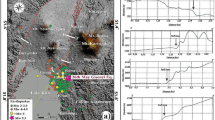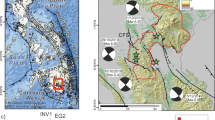Abstract
The strong earthquake with magnitude 6.9 occurred offshore at the northernmost edge of the Samos Island and was strongly felt in the north Aegean islands and İzmir metropolitan city. In this study, the effective elastic thicknesses of the lithosphere and seismogenic layer thickness were correlated with each other in order to understand the nature of the earthquakes. We determined that the upper and lower depth limits of seismogenic layer are in a range of 5–15 km, meaning that only the upper crust is mostly involved in earthquakes in the study area. The fact that seismogenic layer and effective elastic thicknesses are close to each other indicates that the earthquake potential may be within the seismogenic layer. Following that, we estimate the stress field from the geoid undulations as a proxy of gravity potential energy in order to analyze the amplitude and orientation of the stress vectors and seismogenic behavior implications. The discrete wavelet transform has been carried out to decompose the isostatic residual gravity anomalies into horizontal, vertical and diagonal detail coefficients. The results delineated edges of gravity anomalies that reveal some previously unknown features.









Similar content being viewed by others
References
Arısoy MÖ, Dikmen Ü (2011) Potensoft: MATLAB-based software for potential field data processing, modeling and mapping. Comput Geosci 37(7):935–942
Balmino G, Vales N, Bonvalot S, Briais A (2012) Spherical harmonic modelling to ultra-high degree of Bouguer and isostatic anomalies. J Geodesy 86(7):499–520
Barka A (1992). The north Anatolian fault zone. Paper presented at the Annales tectonicae.
Bilim F, Akay T, Aydemir A, Kosaroglu S (2016) Curie point depth, heat-flow and radiogenic heat production deduced from the spectral analysis of the aeromagnetic data for geothermal investigation on the Menderes Massif and the Aegean Region, western Turkey. Geothermics 60:44–57
Biryol CB, Beck SL, Zandt G, Özacar AA (2011) Segmented African lithosphere beneath the Anatolian region inferred from teleseismic P-wave tomography. Geophys J Int 184(3):1037–1057
Bonvalot S, Balmino G, Briais A, Kuhn M, Peyrefitte A, Vales N, Reinquin F (2012). World Gravity Map: a set of global complete spherical Bouguer and isostatic anomaly maps and grids. Paper presented at the EGU general assembly conference abstracts.
Bozkurt E (2001) Neotectonics of Turkey–a synthesis. Geodin Acta 14(1–3):3–30
Braitenberg C, Wienecke S, Ebbing J, Born W, Redfield T (2007) Joint gravity and isostatic analysis for basement studies-a novel tool. Paper presented at the extendended abstracts, EGM 2007 international workshop, innovation in EM, Grav and Mag methods: a new perspective for exploration, Villa Orlandi, Capri-Italy.
Burov E (2010) The equivalent elastic thickness (Te), seismicity and the long-term rheology of continental lithosphere: time to burn-out “crème brûlée”?: insights from large-scale geodynamic modeling. Tectonophysics 484(1–4):4–26
Burov EB, Diament M (1995) The effective elastic thickness (Te) of continental lithosphere: what does it really mean? J Geophys Res Solid Earth 100(B3):3905–3927
Butterworth S (1930) On the theory of filter amplifiers. Wirel Eng 7(6):536–541
Camelbeeck T, de Viron O, Van Camp M, Kusters D (2013) Local stress sources in Western Europe lithosphere from geoid anomalies. Lithosphere 5(3):235–246
Chatzipetros A, Kiratzi A, Sboras S, Zouros N, Pavlides S (2013) Active faulting in the north-eastern Aegean Sea Islands. Tectonophysics 597:106–122
Doğan B (2020) Comparative new insight into the tectonic origin of folds and thrust faults of an extensional basin: Söke-Kuşadası basin, Aegean, Western Turkey. J Earth Sci 31:582–595
Doğru, F., Pamukçu, O., Gönenç, T., and Yıldız, H. (2018). Lithospheric structure of western Anatolia and the Aegean Sea using GOCE-based gravity field models. Bollettino di Geofisica Teorica ed Applicata, 59(2).
Dolmaz M, Hisarli Z, Ustaömer T, Orbay N (2005) Curie point depths based on spectrum analysis of aeromagnetic data, West Anatolian extensional province Turkey. Pure Appl Geophys 162(3):571–590
Emre Ö, Özalp S, Doğan A, Özaksoy V, Yıldırım C, Göktaş F (2005) İzmir Yakın Çevresinin Diri Fayları ve Deprem Potansiyelleri [The Active Faults of the İzmir region and their earthquake potentials]. Mineral research and exploration institute of Turkey (MTA) Report(10754).
Erbek E, Dolmaz MN (2019) Investigation of the thermal structure and radiogenic heat production through aeromagnetic data for the southeastern Aegean Sea and western part of Turkey. Geothermics 81:113–122
Flesch LM, Kreemer C (2010) Gravitational potential energy and regional stress and strain rate fields for continental plateaus: examples from the central Andes and Colorado Plateau. Tectonophysics 482(1–4):182–192
Förste C, Bruinsma S, Abrikosov O, Lemoine J, Schaller T, Götze H, Balmino G (2014) EIGEN-6C4. The latest combined global gravity field model including GOCE data up to degree and order, 2190.
Gaetani M, Jacobshagen V, Nicora A, Kauffmann G, Tselepidis V, Sestini NF, Skourtsis-Coroneou V (1992) The early-middle Triassic boundary at Chios (Greece). Rivista Italiana di Paleontologia e Stratigrafia 98(2):181–204
Ganas A, Elias P, Briole P, Tsironi V, Valkaniotis S, Escartin J, Efstathiou E (2020) Fault responsible for Samos earthquake identified. Temblor. https://doi.org/10.32858/temblor.134
Ghosh A, Holt WE, Flesch LM (2009) Contribution of gravitational potential energy differences to the global stress field. Geophys J Int 179(2):787–812
Gürer ÖF, Bozcu M, Yılmaz K, Yımaz Y (2001) Neogene basin development around Söke-Kuşadası (western Anatolia) and its bearing on tectonic development of the Aegean region. Geodin Acta 14(1–3):57–69
Humphreys ED, Coblentz DD (2007) North American dynamics and western US tectonics. Rev Geophys. https://doi.org/10.1029/2005RG000181
Kaya O (1981) Miocene reference section for the coastal parts of West Anatolia. Newslett Straigraph 10(3):164–191
King GC, Stein RS, Lin J (1994) Static stress changes and the triggering of earthquakes. Bull Seismol Soc Am 84(3):935–953
Kiratzi AA, Svigkas N (2013) A study of the 8 January 2013 Mw5. 8 earthquake sequence (Lemnos Island, East Aegean Sea). Tectonophysics 608:452–460
Kreemer C, Holt WE, Haines AJ (2003) An integrated global model of present-day plate motions and plate boundary deformation. Geophys J Int 154(1):8–34
Kreemer C, Chamot-Rooke N, Le Pichon X (2004) Constraints on the evolution and vertical coherency of deformation in the Northern Aegean from a comparison of geodetic, geologic and seismologic data. Earth Planet Sci Lett 225(3–4):329–346
Kumerics C, Ring U, Brichau S, Glodny J, Monié P (2005) The extensional Messaria shear zone and associated brittle detachment faults, Aegean Sea, Greece. J Geol Soc 162(4):701–721
Maggini M, Caputo R (2021) Seismological data versus rheological modelling: Comparisons across the Aegean Region for improving the seismic hazard assessment. J Struct Geol 145:104312
McClusky S, Balassanian S, Barka A, Demir C, Ergintav S, Georgiev I, Veis G (2000) Global positioning system constraints on plate kinematics and dynamics in the eastern Mediterranean and Caucasus. J Geophys Res Solid Earth 105(B3):5695–5719. https://doi.org/10.1029/1999JB900351
McKenzie D (1978) Active tectonics of the Alpine—Himalayan belt: the Aegean Sea and surrounding regions. Geophys J Int 55(1):217–254
Meng J, Sinoplu O, Zhou Z, Tokay B, Kusky T, Bozkurt E, Wang L (2021) Greece and Turkey Shaken by African tectonic retreat. Sci Rep 11(1):1–10
Müller M, Geiger A, Kahle H-G, Veis G, Billiris H, Paradissis D, Felekis S (2013) Velocity and deformation fields in the North Aegean domain, Greece, and implications for fault kinematics, derived from GPS data 1993–2009. Tectonophysics 597:34–49
Naliboff J, Lithgow-Bertelloni C, Ruff L, de Koker N (2012) The effects of lithospheric thickness and density structure on Earth′ s stress field. Geophys J Int 188(1):1–17
Nomikou P, Evangelidis D, Papanikolaou D, Lampridou D, Litsas D, Tsaparas Y, Koliopanos I (2021) Morphotectonic analysis along the Northern Margin of Samos Island, related to the seismic activity of October 2020, Aegean Sea, Greece. Geosciences, 11(2), 102. Retrieved from https://www.mdpi.com/2076-3263/11/2/102
Oruç B (2014) Structural interpretation of southern part of western Anatolian using analytic signal of the second order gravity gradients and discrete wavelet transform analysis. J Appl Geophys 103:82–98
Pamukçu O, Yurdakul A (2008) Isostatic compensation in western Anatolia with estimate of the effective elastic thickness. Turk J Earth Sci 17(3):545–557
Pamukçu O, Gönenç T, Uyanik O, Sözbilir H, Çakmak O (2014) A microgravity model for the city of İzmir (Western Anatolia) and its tectonic implementations. Acta Geophys 62(4):849–871
Papanikolaou D, Sideris C (1983) Le Paléozoïque de l'autochtone de Chios: une formation à blocs de types wildflysch d'âge Permien (pro parte). Comptes-rendus des séances de l'Académie des sciences. Série 2, Mécanique-physique, chimie, sciences de l'univers, sciences de la terre, 297(7), 603–606.
Papazachos BC, Karakostas V, Papazachos C, Scordilis E (2000) The geometry of the Wadati-Benioff zone and lithospheric kinematics in the Hellenic arc. Tectonophysics 319(4):275–300
Pascal C, Cloetingh SA (2009) Gravitational potential stresses and stress field of passive continental margins: Insights from the south-Norway shelf. Earth Planet Sci Lett 277(3–4):464–473
Reilinger R, McClusky S, Paradissis D, Ergintav S, Vernant P (2010) Geodetic constraints on the tectonic evolution of the Aegean region and strain accumulation along the Hellenic subduction zone. Tectonophysics 488(1–4):22–30
Ring U, Laws S, Bernet M (1999) Structural analysis of a complex nappe sequence and late-orogenic basins from the Aegean Island of Samos. Greece J Struct Geol 21(11):1575–1601
Röckel T, Lempp C (2003) Der Spannungszustand im Norddeutschen Becken. Erdöl Erdgas Kohle 119(2):73–80
Roth F, Fleckenstein P (2001) Stress orientations found in north-east Germany differ from the West European trend. Terra Nova 13(4):289–296
Seyitoglu G, Kaypak B, Esat K, Koca B (2020) 2020.10.30 (Mww=7.0) Sisam depremi ve artçılarının Ege’nin neotektonik çerçevesinin anlaşılmasına katkıları/Contributions of the 2020.10.30 (Mww=7.0) Samos earthquake and its aftershocks to the understanding of Aegean neotectonic framework.
Stein RS, Barka AA, Dieterich JH (1997) Progressive failure on the North Anatolian fault since 1939 by earthquake stress triggering. Geophys J Int 128(3):594–604
Sümer Ö, İnci U, Sözbilir H (2013) Tectonic evolution of the Söke Basin: extension-dominated transtensional basin formation in western part of the Büyük Menderes Graben, Western Anatolia, Turkey. J Geodyn 65:148–175
Tur H, Yaltırak C, Elitez İ, Sarıkavak KT (2015) Pliocene-Quaternary tectonic evolution of the Gulf of Gökova, southwest Turkey. Tectonophysics 638:158–176
Turcotte DL, Schubert G (2002) Geodynamics. Cambridge University Press, Cmabridge
Uzel B, Sözbilir H, Bora U (2008) A first record of a strike-slip basin in western Anatolia and its tectonic implication: the Cumaovası Basin. Turk J Earth Sci 17(3):559–591
Uzel B, Sözbilir H, Özkaymak Ç (2012) Neotectonic evolution of an actively growing superimposed basin in western Anatolia: the inner bay of Izmir, Turkey. Turk J Earth Sci 21(4):439–471
Uzel B, Sözbilir H, Özkaymak Ç, Kaymakcı N, Langereis CG (2013) Structural evidence for strike-slip deformation in the İzmir-Balıkesir transfer zone and consequences for late Cenozoic evolution of western Anatolia (Turkey). J Geodyn 65:94–116
Uzel B, Langereis CG, Kaymakci N, Sözbilir H, Özkaymak Ç, Özkaptan M (2015) Paleomagnetic evidence for an inverse rotation history of Western Anatolia during the exhumation of Menderes core complex. Earth Planet Sci Lett 414:108–125
Vernant P, Reilinger R, McClusky S (2014) Geodetic evidence for low coupling on the Hellenic subduction plate interface. Earth Planet Sci Lett 385:122–129
Zoback ML (1992) First-and second-order patterns of stress in the lithosphere: the world stress map project. J Geophys Res Solid Earth 97(B8):11703–11728
Acknowledgements
The authors would like to express their gratitude for the valuable responses of two anonymous reviewers. Thanks also to our colleagues Fikret Doğru for providing EET data and Ezgi Erbek for heat flow data.
Author information
Authors and Affiliations
Corresponding author
Ethics declarations
Conflict of interest
The authors declare that they have no conflict of interest.
Additional information
Communicated by the Guest Editors: Ramon Zuñiga, Eleftheria Papadimitriou, Vassilios Karakostas and Onur Tan.
Rights and permissions
About this article
Cite this article
Oruç, B., Balkan, E. Stress field estimation by the geoid undulations of the Samos-Kuşadası Bay and implications for seismogenic behavior. Acta Geophys. 69, 1137–1149 (2021). https://doi.org/10.1007/s11600-021-00604-7
Received:
Accepted:
Published:
Issue Date:
DOI: https://doi.org/10.1007/s11600-021-00604-7




